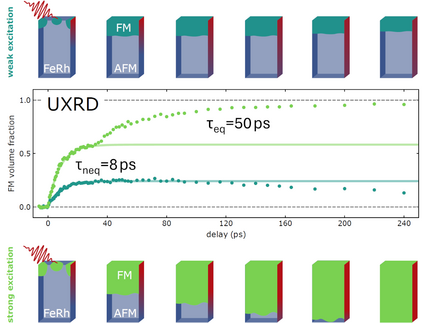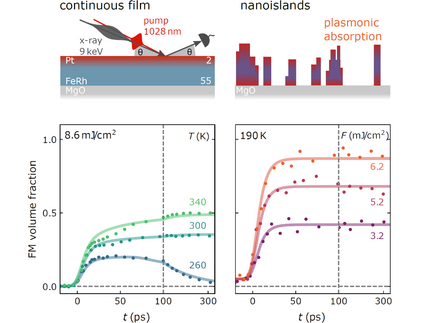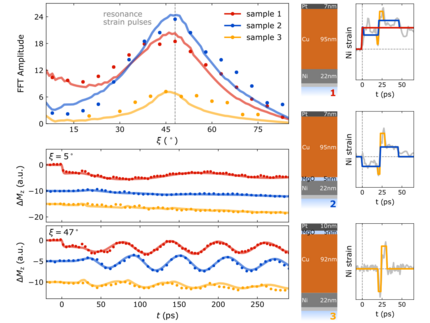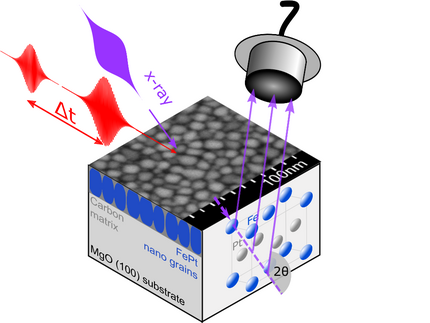Ultrafast magnetism
This research field has roots in the applictions for magnetic data processing and storage. The coupling of spin excitations to electrons and phonons is a formidable challenge to experiment and theoretical modeling. We focus on understanding the coupling of phonons and spin excitations in both directions: Coherent and incoherent phonons (strain and heat) can be used to control magnetization dynamics (spin waves) via inverse magnetostriction and changes of the anisotropy fields. Directly exciting spins or heating them optically via the electronic absorption can induce considerable spin disorder, which drives local stress on the lattice. This is particularly rewarding in cases where the stress driven by spin-entropy leads to negative thermal expansion. Our specialty is to combine ultrafast x-ray difffraction (UXRD) and transient magneto-optical Kerr effect (MOKE) experiments in order so selectively probe the spin and lattcie systems.
The investigated thin film as well as nanostructured heterostructures are composed of materials ranging from Ni, FePt and rare earths (Ho, Dy, Gd, TbFe2) via magnetic perovskite oxides such as SrRuO3 and LaSrMnO3 to iron garnets (Bi:YIG).
Related publications
M. Mattern, J. Jarecki, J. A. Arregi, V. Uhlíř, M. Rössle, and M. Bargheer
Speed limits of the laser-induced phase transition in FeRh
APL Materials 12, 051124 (2024).
We use ultrafast x-ray diffraction and the polar time-resolved magneto-optical Kerr effect to study the laser-induced metamagnetic phase transition in two FeRh films with thicknesses below and above the optical penetration depth. In the thin film, we identify an intrinsic timescale for the light-induced nucleation of ferromagnetic (FM) domains in the antiferromagnetic material of 8ps, which is substantially longer than the time it takes for strain waves to traverse the film. For the inhomogeneously excited thicker film, only the optically excited near-surface part transforms within 8ps. For strong excitations, we observe an additional slow rise of the FM phase, which we experimentally relate to a growth of the FM phase into the depth of the layer by comparing the transient magnetization in frontside and backside excitation geometry. In the lower lying parts of the film, which are only excited via near-equilibrium heat transport, the FM phase emerges significantly slower than 8ps after heating above the transition temperature.
M. Mattern, J.-E. Pudell, J. A. Arregi, J. Zlámal, R. Kalousek, V. Uhlíř, M. Rössle, and M. Bargheer
Accelerating the Laser-Induced Phase Transition in Nanostructured FeRh via Plasmonic Absorption
Advanced Functional Materials, 2313014 (2024).
By ultrafast x-ray diffraction (UXRD), it is shown that the laser-induced magnetostructural phase transition in FeRh nanoislands proceeds faster and more complete than in continuous films. An intrinsic 8 ps timescale is observed for the nucleation of ferromagnetic (FM) domains in the optically excited fraction of both types of samples. For the continuous film, the substrate-near regions are not directly exposed to light and are only slowly transformed to the FM state after heating above the transition temperature via near-equilibrium heat transport. Numerical modeling of the absorption in the investigated nanoislands reveals a strong plasmonic contribution near the FeRh/MgO interface. The larger absorption and the optical excitation of the electrons in nearly the entire volume of the nanoislands enables a rapid phase transition throughout the entire volume at the intrinsic nucleation timescale.
Jarecki J., Mattern M., Weber F.-C., Pudell J.-E., Wang X.-G., Rojas-Sánchez J.-C., Hehn M., von Reppert A., and Bargheer M.
Controlling effective field contributions to laser-induced magnetization precession by heterostructure design
Communications Physics 7, 12 (2024).
Nanoscale heterostructure design can control laser-induced heat dissipation and strain propagation, as well as their efficiency for driving magnetization precession. Here, we incorporate MgO layers into the experimental platform of metallic Pt-Cu-Ni heterostructures to block the propagation of hot electrons. We show via ultrafast x-ray diffraction the capability of our platform to control the spatio-temporal shape of the transient heat and strain. Time-resolved magneto-optical Kerr experiments with systematic tuning of the magnetization precession frequency showcase control of the magnetization dynamics in the Ni layer. Our experimental analysis highlights the role of quasi-static strain as a driver of precession when the magnetic material is rapidly heated via electrons. The effective magnetic field change originating from demagnetization partially compensates the change induced by quasi-static strain. The strain pulses can be shaped via the nanoscale heterostructure design to efficiently drive the precession, paving the way for opto-magneto-acoustic devices with low heat energy deposited in the magnetic layer.
Mattern M., Weber F.-C., Engel D., von Korff Schmising C., and Bargheer M.
Coherent control of magnetization precession by double-pulse activation of effective fields from magnetoacoustics and demagnetization
Applied Physics Letters 124, 102402 (2024).
We demonstrate the coherent optical control of magnetization precession in a thin Ni film by a second excitation pulse, which amplifies or attenuates the precession induced by a first pulse depending on the fluences of the pump-pulses and the pump-pump delay. This control goes beyond the conventional strategy, where the same mechanism drives the precession in-phase or out-of-phase. We balance the magneto-acoustic mechanism driven by quasi-static strain and the shape-anisotropy change triggered by laser-induced demagnetization. These mechanisms tilt the transient effective magnetic field in opposite directions in the case of negative magneto-elastic coupling (b1<0). While the strain response is linear in the fluence, demagnetization is nonlinear near the Curie temperature, enabling fluence-based control scenarios.
Rongione E., Gueckstock O., Mattern M.,Gomonay O., Meer H., Schmitt C., Ramos R., Kikkawa T., Mičica M., Saitoh E., Sonova J., Jaffrès H., Mangeney J., Goennenwein S.T.B., Geprägs S., Kampfrath T., Kläui M., Bargheer M., Seifert T.S., Dhillon S., and Lebrun R.
Emission of coherent THz magnons in an antiferromagnetic insulator triggered by ultrafast spin–phonon interactions
Nature Communications 14, Article number: 1818 (2023)
Antiferromagnetic materials have been proposed as new types of narrowband THz spintronic devices owing to their ultrafast spin dynamics. Manipulating coherently their spin dynamics, however, remains a key challenge that is envisioned to be accomplished by spin-orbit torques or direct optical excitations. Here, we demonstrate the combined generation of broadband THz (incoherent) magnons and narrowband (coherent) magnons at 1 THz in low damping thin films of NiO/Pt. We evidence, experimentally and through modeling, two excitation processes of spin dynamics in NiO: an off-resonant instantaneous optical spin torque in (111) oriented films and a strain-wave-induced THz torque induced by ultrafast Pt excitation in (001) oriented films. Both phenomena lead to the emission of a THz signal through the inverse spin Hall effect in the adjacent heavy metal layer. We unravel the characteristic timescales of the two excitation processes found to be < 50 fs and > 300 fs, respectively, and thus open new routes towards the development of fast opto-spintronic devices based on antiferromagnetic materials.
Mattern M., Pudell J.-E., Dumesnil K., von Reppert A., and Bargheer M.
Towards shaping picosecond strain pulses via magnetostrictive transducers
Photoacoustics 30, 100463 (2023).
Using time-resolved x-ray diffraction, we demonstrate the manipulation of the picosecond strain response of a metallic heterostructure consisting of a dysprosium (Dy) transducer and a niobium (Nb) detection layer by an external magnetic field. We utilize the first-order ferromagnetic–antiferromagnetic phase transition of the Dy layer, which provides an additional large contractive stress upon laser excitation compared to its zero-field response. This enhances the laser-induced contraction of the transducer and changes the shape of the picosecond strain pulses driven in Dy and detected within the buried Nb layer. Based on our experiment with rare-earth metals we discuss required properties for functional transducers, which may allow for novel field-control of the emitted picosecond strain pulses.
Deb M., Popova E., Jaffrès H.-Y., Keller N., and Bargheer M.
Polarization-dependent subpicosecond demagnetization in iron garnets
Physical Review B 106, 184416 (2022).
Controlling the magnetization dynamics at the fastest speed is a major issue of fundamental condensed matter physics and its applications for data storage and processing technologies. It requires a deep understanding of the interactions between the degrees of freedom in solids, such as spin, electron, and lattice as well as their responses to external stimuli. In this paper, we systematically investigate the fluence dependence of ultrafast magnetization dynamics induced by below-bandgap ultrashort laser pulses in the ferrimagnetic insulators Bi(x)Y(3−x)Fe5O12 with 1≤x≤3. We demonstrate subpicosecond demagnetization dynamics in this material followed by a very slow remagnetization process. We prove that this demagnetization results from an ultrafast heating of iron garnets by two-photon absorption (TPA), suggesting a phonon-magnon thermalization time of ≤0.6 ps. We explain the slow remagnetization timescale by the low phonon heat conductivity in garnets. Additionally, we show that the amplitudes of the demagnetization, optical change, and lattice strain can be manipulated by changing the ellipticity of the pump pulses. We explain this phenomenon considering the TPA circular dichroism. These findings open exciting prospects for ultrafast manipulation of spin, charge, and lattice dynamics in magnetic insulators by ultrafast nonlinear optics.
Deb M., Popova E., Jaffrès H.-Y., Keller N., and Bargheer M.
Controlling High-Frequency Spin-Wave Dynamics Using Double-Pulse Laser Excitation
Physical Review Applied 18, 044001 (2022).
Manipulating spin waves is highly required for the development of innovative data transport and processing technologies. Recently, the possibility of triggering high-frequency standing spin waves in magnetic insulators using femtosecond laser pulses was discovered, raising the question about how one can manipulate their dynamics. Here we explore this question by investigating the ultrafast magnetization and spin-wave dynamics induced by double-pulse laser excitation. We demonstrate a suppression or enhancement of the amplitudes of the standing spin waves by precisely tuning the time delay between the two pulses. The results can be understood as the constructive or destructive interference of the spin waves induced by the first and second laser pulses. Our findings open exciting perspectives towards generating single-mode standing spin waves that combine high frequency with large amplitude and low magnetic damping.
Deb M., Popova E., Zeuschner S. P., Leitenberger W., Keller N., Rössle M., and Bargheer M.
Ultrafast control of lattice strain via magnetic circular dichroism
Physical Review B 103, 064301 (2021).
Using ultrafast x-ray diffraction, we directly monitor the lattice dynamics induced by femtosecond laser pulses in nanoscale thin films of bismuth iron garnet in external magnetic fields H_ext . We control the ultrafast laserinduced lattice strain amplitude by changing the laser pulse helicity. The strength of H_ext is used as an external parameter to switch the helicity dependence on and off, respectively. Based on magneto-optical spectroscopic measurements, we explain these phenomena by magnetic circular dichroism. Our findings highlight an important approach for ultrafast manipulation of lattice strain in magnetic materials, in particular insulators, and open exciting perspectives towards ultrafast control of lattice strain and heat-induced magnetization switching and spin waves in bismuth-substituted iron garnets using the polarization of light.
Mattern M., Pudell J.-E., Laskin G., von Reppert A., and Bargheer M.
Analysis of the temperature- and fluence-dependent magnetic stress in laser-excited SrRuO3
Structural Dynamics 8, 024302 (2021).
We use ultrafast x-ray diffraction to investigate the effect of expansive phononic and contractive magnetic stress driving the picosecond strain response of a metallic perovskite SrRuO3 thin film upon femtosecond laser excitation. We exemplify how the anisotropic bulk equilibrium thermal expansion can be used to predict the response of the thin film to ultrafast deposition of energy. It is key to consider that the laterally homogeneous laser excitation changes the strain response compared to the near-equilibrium thermal expansion because the balanced in-plane stresses suppress the Poisson stress on the picosecond timescale. We find a very large negative Grüneisen constant describing the large contractive stress imposed by a small amount of energy in the spin system. The temperature and fluence dependence of the strain response for a double-pulse excitation scheme demonstrates the saturation of the magnetic stress in the high-fluence regime.
Deb M., Popova E., Zeuschner S. P., Hehn M., Keller N., Mangin S., Malinowski G., and Bargheer M.
Generation of spin waves via spin-phonon interaction in a buried dielectric thin film
Physical Review B 103, 024411 (2021).
In this paper, we investigate the magnetic, optical, and lattice responses of a Pt/Cu/Bi1Y2Fe5O12/Gd3Ga5O12 heterostructure to femtosecond laser excitation of the opaque Pt/Cu metallic bilayer. The electronic excitation generates coherent and incoherent phonons, which trigger high-frequency standing spin waves (SWs) in the dielectric Bi1Y2Fe5O12 layer via a phonon-induced change of magnetic anisotropy. We find that the incoherent phonons (heat) can induce a fast (<1ps) and slow (>1000ps) decrease of the magnetic order by different spin-phonon interaction scenarios. These results open perspectives for generating high-frequency SWs in buried magnetic garnets.
Reppert A. v., Willig L., Pudell J.-E., Zeuschner S. P., Sellge G., Ganss F., Hellwig O., Arregi J. A., Uhlíř V., Crut A., and Bargheer M.
Spin stress contribution to the lattice dynamics of FePt
Science Advances 6, eaba1142 (2020)
Invar-behavior occurring in many magnetic materials has long been of interest to materials science. Here, we show not only invar behavior of a continuous film of FePt but also even negative thermal expansion of FePt nanograins upon equilibrium heating. Yet, both samples exhibit pronounced transient expansion upon laser heating in femtosecond x-ray diffraction experiments. We show that the granular microstructure is essential to support the contractive out-of-plane stresses originating from in-plane expansion via the Poisson effect that add to the uniaxial contractive stress driven by spin disorder. We prove the spin contribution by saturating the magnetic excitations with a first laser pulse and then detecting the purely expansive response to a second pulse. The contractive spin stress is reestablished on the same 100-ps time scale that we observe for the recovery of the ferromagnetic order. Finite-element modeling of the mechanical response of FePt nanosystems confirms the morphology dependence of the dynamics.
Reppert A. v., Matter M., Pudell J.-E., Zeuschner S. P., Dumesnil K., and Bargheer M.
Unconventional picosecond strain pulses resulting from the saturation of magnetic stress within a photoexcited rare earth layer
Structural Dynamics 7, 024303 (2020).
Optical excitation of spin-ordered rare earth metals triggers a complex response of the crystal lattice since expansive stresses from electron and phonon excitations compete with a contractive stress induced by spin disorder. Using ultrafast x-ray diffraction experiments, we study the layer specific strain response of a dysprosium film within a metallic heterostructure upon femtosecond laser-excitation. The elastic and diffusive transport of energy to an adjacent, non-excited detection layer clearly separates the contributions of strain pulses and thermal excitations in the time domain. We find that energy transfer processes to magnetic excitations significantly modify the observed conventional bipolar strain wave into a unipolar pulse. By modeling the spin system as a saturable energy reservoir that generates substantial contractive stress on ultrafast timescales, we can reproduce the observed strain response and estimate the time- and space-dependent magnetic stress. The saturation of the magnetic stress contribution yields a non-monotonous total stress within the nanolayer, which leads to unconventional picosecond strain pulses.
Willig L., von Reppert A., Deb M., Ganss F., Hellwig O., and Bargheer M.
Finite-size effects in ultrafast remagnetization dynamics of FePt
Physical Review B 100, 224408 (2019).
We investigate the ultrafast magnetization dynamics of FePt in the L10 phase after an optical heating pulse, as used in heat-assisted magnetic recording. We compare continuous and nano-granular thin films and emphasize the impact of the finite size on the remagnetization dynamics. The remagnetization speeds up significantly with increasing external magnetic field only for the continuous film, where domain-wall motion governs the dynamics. The ultrafast remagnetization dynamics in the continuous film are only dominated by heat transport in the regime of high magnetic fields, whereas the timescale required for cooling is prevalent in the granular film for all magnetic field strengths. These findings highlight the necessary conditions for studying the intrinsic heat transport properties in magnetic materials.
Deb M., Popova E., Hehn M., Keller N., Petit-Watelot S., Bargheer M., Mangin S., Malinowski G.
Damping of Standing Spin Waves in Bismuth-Substituted Yttrium Iron Garnet as Seen via the Time-Resolved Magneto-Optical Kerr Effect
Physical Review Applied 12, 044006 (2019).
We investigate spin-wave resonance modes and their damping in insulating thin films of bismuth-substituted yttrium iron garnet by performing femtosecond magneto-optical pump-probe experiments. For large magnetic fields in the range below the magnetization saturation, we find that the damping of high-order standing spin-wave (SSW) modes is about 40 times lower than that for the fundamental one. The observed phenomenon can be explained by considering different features of magnetic anisotropy and exchange fields that, respectively, define the precession frequency for fundamental and high-order SSWs. These results provide further insight into SSWs in iron garnets and may be exploited in many new photomagnonic devices.
Deb M., Popova E., Hehn M., Keller N., Petit-Watelot S., Bargheer M., Mangin S., and Malinowski G.
Femtosecond Laser-Excitation-Driven High Frequency Standing Spin Waves in Nanoscale Dielectric Thin Films of Iron Garnets
Physical Review Letters 123, 027202 (2019).
We demonstrate that femtosecond laser pulses allow triggering high-frequency standing spin-wave modes in nanoscale thin films of a bismuth-substituted yttrium iron garnet. By varying the strength of the external magnetic field, we prove that two distinct branches of the dispersion relation are excited for all the modes. This is reflected in particular at a very weak magnetic field (∼33 mT) by a spin dynamics with a frequency up to 15 GHz, which is 15 times higher than the one associated with the ferromagnetic resonance mode. We argue that this phenomenon is triggered by ultrafast changes of the magnetic anisotropy via laser excitation of incoherent and coherent phonons. These findings open exciting prospects for ultrafast photo magnonics.
Zeuschner, S. P., Parpiiev T., Pezeril T., Hillion A., Dumesnil K., Anane A., Pudell J.-E., Willig L., Rössle M., Herzog M., Reppert A. v., and Bargheer M.
Tracking picosecond strain pulses in heterostructures that exhibit giant magnetostriction
Structural Dynamics 6, 024302 (2019).
We combine ultrafast X-ray diffraction (UXRD) and time-resolved Magneto-Optical Kerr Effect (MOKE) measurements to monitor the strain pulses in laser-excited TbFe2/Nb heterostructures. Spatial separation of the Nb detection layer from the laser excitation region allows for a background-free characterization of the laser-generated strain pulses. We clearly observe symmetric bipolar strain pulses if the excited TbFe2 surface terminates the sample and a decomposition of the strain wavepacket into an asymmetric bipolar and a unipolar pulse, if a SiO2 glass capping layer covers the excited TbFe2 layer. The inverse magnetostriction of the temporally separated unipolar strain pulses in this sample leads to a MOKE signal that linearly depends on the strain pulse amplitude measured through UXRD. Linear chain model simulations accurately predict the timing and shape of UXRD and MOKE signals that are caused by the strain reflections from multiple interfaces in the heterostructure.
Pudell J.-E., Reppert A. v., Schick D., Zamponi F., Rössle M., Herzog M., Zabel H., and Bargheer M.
Ultrafast negative thermal expansion driven by spin disorder
Physical Review B 99, 094304 (2019).
We measure the transient strain profile in a nanoscale multilayer system composed of yttrium, holmium,
and niobium after laser excitation using ultrafast x-ray diffraction. The strain propagation through each
layer is determined by transient changes in the material-specific Bragg angles. We experimentally derive the
exponentially decreasing stress profile driving the strain wave and show that it closely matches the optical
penetration depth. Below the Néel temperature of Ho, the optical excitation triggers negative thermal expansion,
which is induced by a quasi-instantaneous contractive stress and a second contractive stress contribution
increasing on a 12-ps timescale. These two timescales were recently measured for the spin disordering in Ho
[Rettig et al., Phys. Rev. Lett. 116, 257202 (2016)]. As a consequence, we observe an unconventional bipolar
strain pulse with an inverted sign traveling through the heterostructure.
Reppert A. v., Willig L., Pudell J.-E., Rössle M., Leitenberger W., Herzog M., Ganss F., Hellwig O., and Bargheer M.
Ultrafast laser generated strain in granular and continuous FePt thin films
Applied Physics Letters 113, 123101 (2019).
We employ ultrafast X-ray diffraction to compare the lattice dynamics of laser-excited continuous and granular FePt films on MgO (100) substrates. Contrary to recent results on free-standing granular films, we observe in both cases a pronounced and long-lasting out-of-plane expansion. We attribute this discrepancy to the in-plane expansion, which is suppressed by symmetry in continuous films. Granular films on substrates are less constrained and already show a reduced out-of-plane contraction. Via the Poisson effect, out-of-plane contractions drive in-plane expansion and vice versa. Consistently, the granular film exhibits a short-lived out-of-plane contraction driven by ultrafast demagnetization which is followed by a reduced and delayed expansion. From the acoustic reflections of the observed strain waves at the film-substrate interface, we extract a 13% reduction of the elastic constants in thin 10 nm FePt films compared to bulk-like samples.




















